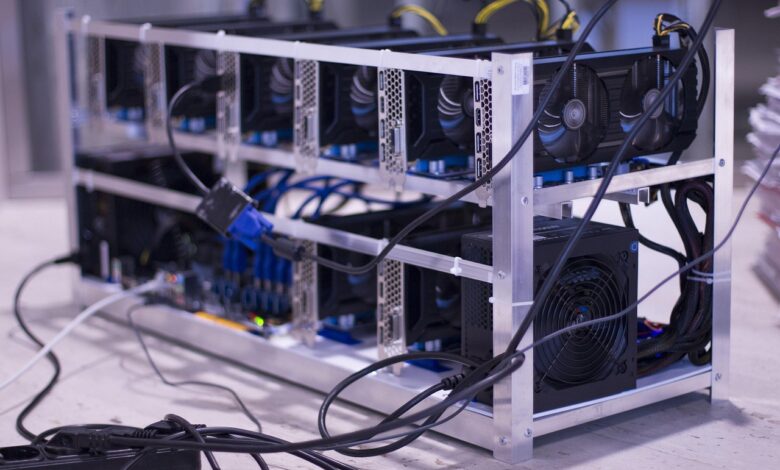Cryptocurrency mining – digital asset creation

Successful participation in mining requires specialized hardware designed to perform complex calculations with maximum efficiency. This computational work validates transactions and secures the network through a consensus mechanism known as proof of work. Miners compete to solve cryptographic puzzles, and the first to find a valid solution earns rewards in the form of newly minted tokens.
The process transforms raw computational power into tangible value by generating unique units of currency that can be traded or held as investments. Optimizing energy consumption and processing speed directly impacts profitability, making hardware selection and maintenance critical factors for sustainable operation.
Proof mechanisms ensure fairness by linking output to verifiable computational effort, preventing fraudulent claims of reward. Understanding these protocols allows operators to anticipate difficulty adjustments and tailor their infrastructure accordingly. The intersection of algorithmic design and physical equipment underpins this intricate system of asset generation.
Cryptocurrency mining: digital asset creation [Digital Finance digital-finance]
To optimize the process of token generation through computational validation, it is crucial to leverage high-performance hardware designed for intensive processing tasks. Specialized equipment such as Application-Specific Integrated Circuits (ASICs) and advanced Graphics Processing Units (GPUs) have demonstrated superior efficiency compared to general-purpose processors, directly influencing profitability by reducing energy consumption per unit of computational work.
The underlying mechanism ensuring transactional integrity and network consensus is the Proof-of-Work protocol, which requires participants to solve complex cryptographic puzzles. Successful resolution grants network participants rewards in the form of newly minted units, incentivizing continuous participation and securing the ledger against fraudulent entries.
Technical Dynamics of Token Generation
The process entails repetitive hashing operations where miners compete to find a nonce value that produces a hash output below a target threshold. This probabilistic challenge maintains block time consistency and adjusts difficulty based on total network computational power. For instance, Bitcoin’s algorithm recalibrates approximately every two weeks, reflecting fluctuations in global processing capacity to stabilize issuance rate.
Hardware selection significantly impacts operational viability; ASIC miners tailored for SHA-256 hashing outperform GPUs in throughput and energy efficiency. However, alternative protocols like Ethash used in Ethereum favor memory-intensive computations, making GPUs more suitable. These variances necessitate strategic hardware deployment aligned with the specific algorithmic requirements of the currency being secured.
Economic viability further depends on balancing electricity costs against expected returns from block rewards and transaction fees. Case studies reveal that regions offering low-cost energy enhance competitive advantage for operators. Additionally, evolving regulatory frameworks influence market dynamics by altering access to resources or imposing constraints on mining activities, thereby affecting supply and demand fundamentals.
Emerging consensus models such as Proof-of-Stake present alternatives to traditional work-based validation by eliminating energy-intensive calculations while maintaining decentralization and security principles. Nevertheless, current systems relying on proof mechanisms continue to dominate due to established infrastructure and proven resilience, underscoring ongoing relevance despite environmental concerns.
Choosing Hardware for Mining
Selecting the appropriate equipment to perform computational work in blockchain validation directly impacts the efficiency and profitability of generating new tokens. ASICs (Application-Specific Integrated Circuits) deliver unmatched hashing power and energy efficiency, making them the preferred choice for networks utilizing proof-of-work consensus mechanisms such as Bitcoin. However, their high upfront cost and lack of versatility may not suit all participants.
Conversely, GPUs (Graphics Processing Units) offer greater flexibility across various algorithms and cryptocurrencies but typically provide lower hash rates per watt compared to ASICs. Evaluating hardware requires balancing initial investment against expected returns, factoring in electricity expenses, network difficulty adjustments, and potential rewards from block validation or transaction fees.
Technical Parameters Influencing Equipment Selection
Key specifications include hash rate, power consumption, and thermal management capabilities. For instance, a Bitmain Antminer S19 Pro can achieve approximately 110 TH/s at around 3250 watts, yielding a performance ratio near 34 J/TH. In contrast, an NVIDIA RTX 3080 GPU produces roughly 85 MH/s on Ethereum’s Ethash algorithm while consuming approximately 220 watts. Such metrics guide decisions aligned with specific protocol requirements.
Additionally, cooling solutions are critical since sustained high workloads generate significant heat that can degrade components or reduce operational lifespan. Efficient airflow designs or liquid cooling systems enhance stability and maintain consistent throughput necessary for maximizing mining revenue over time.
Diversification Through Equipment Variety
Deploying mixed hardware setups can mitigate risks related to changes in network difficulty or shifts toward alternative consensus models such as proof-of-stake hybrids. For example:
- ASIC units dedicated to SHA-256 networks enable focused work on Bitcoin-like chains.
- GPUs adaptable to multiple algorithms support emerging projects requiring memory-intensive computations.
- FPGA devices offer customizable logic blocks enabling intermediate performance with lower power draw but require advanced technical expertise.
This diversified approach enhances resilience against market volatility while optimizing reward streams across different protocols.
Case Study: Hardware Efficiency Impact on Profitability
*Dependent on network conditions; Based on current Ethereum pricing and difficulty; *Used mostly in experimental setups or custom protocols.
The Role of Consensus Proof Types in Hardware Choice
The type of cryptographic proof required influences hardware effectiveness significantly. Proof-of-work demands intense computational effort measured via hash rates to solve complex puzzles rapidly. Alternative systems like proof-of-stake eliminate heavy computational work by relying on token holdings for validation rights, reducing the necessity for specialized machinery. Understanding these distinctions aids in targeting investments towards suitable equipment aligned with the protocol’s operational framework.
Evolving Regulatory and Market Considerations Affecting Equipment Investment
Lately, regulatory frameworks addressing energy consumption have incentivized deploying more efficient or renewable-powered setups due to environmental concerns associated with extensive processing work. Moreover, fluctuations in token valuations impact expected remuneration from block generation activities–prompting continuous reassessment of hardware viability within portfolios designed for long-term participation in decentralized ledger ecosystems.
The integration of real-time financial data alongside technical benchmarks enables informed decisions ensuring resource allocation maximizes returns while adhering to evolving compliance standards globally.
Setting up mining software
Selecting compatible mining software tailored to your computational setup is fundamental for efficient token generation. The choice depends heavily on the consensus algorithm employed by the blockchain protocol, with Proof of Work (PoW) requiring high-performance processing units to solve complex cryptographic puzzles. Software solutions such as CGMiner and BFGMiner support multiple hardware types, including ASICs and GPUs, facilitating optimized workload distribution and hash rate maximization.
Installation requires precise configuration aligned with your equipment specifications and network parameters. Key settings include pool addresses for cooperative validation, worker identification credentials, and tuning parameters for intensity and thread concurrency. Adjusting these variables influences both energy consumption and throughput, directly affecting profitability margins in the competitive ledger extension process.
Technical considerations for optimal performance
Hardware compatibility plays a decisive role in operational efficiency; ASIC miners deliver superior hashing power per watt compared to GPUs but lack versatility across different algorithms. Ensuring firmware is up-to-date reduces latency in block validation tasks while minimizing error rates during nonce computations. Integrating monitoring tools within the mining client enables real-time diagnostics of temperature fluctuations and hashrate stability.
Security protocols must be rigorously applied to prevent unauthorized access that could disrupt reward distribution or compromise wallet integrity. Implementing encrypted communication channels via Stratum V2 or equivalent protocols enhances data transfer reliability between nodes and minimizes susceptibility to man-in-the-middle attacks. Periodic updates addressing vulnerabilities contribute to sustained system resilience against evolving cyber threats.
Calculating Mining Profitability
To accurately determine the profitability of mining operations, one must first evaluate the performance and efficiency of the hardware employed. Modern mining devices, such as ASICs or high-end GPUs, deliver varying hashes per second rates, which directly influence the amount of work completed in verifying transactions through proof mechanisms. Higher hash rates increase the chance of earning rewards but also consume more electricity, making power costs a critical factor in overall profitability.
Another core component is understanding the reward structure tied to block validation. Each successful contribution to ledger maintenance results in a fixed or variable token issuance combined with transaction fees. Calculating expected returns requires integrating current network difficulty levels and block intervals to estimate how often a miner or pool can expect to receive these incentives over time.
Key Variables Impacting Profit Margins
The complexity of proof algorithms significantly affects resource consumption and thus financial outcomes. For example, Proof-of-Work consensus demands substantial computational effort, translating into elevated energy use and hardware wear. In contrast, alternative proofs may reduce operational strain but also typically yield different reward models. Effective analysis includes benchmarking device efficiency expressed as joules per terahash alongside average uptime to project realistic output rates.
Operational expenditures extend beyond electricity and device acquisition costs; cooling infrastructure and maintenance are non-negligible expenses that diminish net gains. Case studies from large-scale facilities demonstrate that optimizing ambient conditions can improve hardware longevity and reduce downtime, amplifying cumulative rewards despite initial capital investments.
Market volatility in token valuation introduces an additional layer of complexity when forecasting profit potential. A rigorous approach involves modeling multiple price scenarios supported by historical data trends and macroeconomic indicators affecting supply-demand dynamics within the ecosystem. Integrating real-time metrics from mining pools provides actionable insights into shifts in network hash rate distribution and emerging competition levels.
A comprehensive profitability model synthesizes these parameters using formulaic calculations such as:
- Total Work Output: Hash rate × uptime × efficiency factor;
- Expected Rewards: (Block reward + fees) × probability based on work contributed;
- Total Costs: Energy consumption × local electricity price + amortized hardware expenses + auxiliary costs;
- Net Profit: Expected rewards minus total costs over defined period.
This quantitative framework enables miners to forecast returns under varied scenarios and adjust strategies accordingly–whether by upgrading equipment, relocating operations for cheaper power, or switching participation modes between solo mining and pool collaboration for risk diversification.
Managing Energy Consumption
Optimizing energy usage in the process of verifying transactions through computational work is pivotal to balancing operational costs and environmental impact. The consensus mechanism based on proof-of-work demands significant electrical power, with some large-scale operations consuming upwards of 1 GW per facility. Employing renewable sources such as hydroelectric or solar power can reduce carbon footprints while maintaining network security and continuity of reward distribution.
The economic incentive structure, where miners receive rewards for solving complex mathematical puzzles, influences energy consumption patterns. Efficient hardware advancements like ASICs have increased hash rates per watt, lowering overall energy requirements. However, scaling these gains requires strategic deployment in regions with low electricity prices and stable grids to prevent volatility in profitability and maintain consistent participation in transaction validation.
Technical Approaches to Energy Efficiency
Transitioning from traditional computational frameworks to hybrid or alternative consensus models presents a viable method for managing power draw without compromising system integrity. For example:
- Implementing proof-of-stake algorithms reduces dependence on exhaustive computations by selecting validators proportionally to their holdings.
- Layer-2 solutions alleviate mainchain load, indirectly decreasing work-related energy needs.
- Dynamic difficulty adjustment ensures that required effort corresponds more closely with network conditions, optimizing resource allocation.
Case studies from entities utilizing waste heat recovery systems demonstrate additional avenues for improving sustainability. Facilities repurpose thermal energy generated during calculations into heating or industrial processes, effectively converting electrical input into dual-purpose output and enhancing overall energy economy.
Regulatory frameworks are increasingly factoring into operational strategies, prompting adoption of stringent efficiency standards and incentivizing low-impact participation methods. Monitoring real-time grid stability metrics alongside mining activity allows operators to modulate workload dynamically, preventing peak demand surges and aligning consumption with off-peak periods. This measured approach supports long-term viability of token issuance mechanisms tied to computational proofs while addressing environmental concerns.
Securing Mined Coins: Technical Imperatives and Future Outlook
Ensuring the integrity and security of rewards generated through computational effort hinges on robust consensus mechanisms like proof-of-work. The interplay between efficient hardware utilization and cryptographic validation safeguards the ownership and transferability of these tokens, directly impacting their resilience against double-spending or unauthorized manipulation.
Advanced mining rigs equipped with specialized ASICs or GPUs not only optimize the verification workload but also introduce new vectors for hardware-level attacks. Consequently, continuous firmware updates and secure enclave technologies become indispensable to maintaining network trustworthiness while maximizing output efficiency.
Strategic Considerations for Strengthening Token Security
- Consensus Robustness: Proof-of-work remains a dominant protocol ensuring that each unit’s creation is backed by verifiable computational effort, deterring fraudulent issuance.
- Hardware Integrity: Employ tamper-resistant components with real-time monitoring to prevent malicious firmware injections that could manipulate reward calculations or leak sensitive cryptographic keys.
- Network Layer Protection: Utilize encrypted communication channels and decentralized node validation to reduce susceptibility to Sybil attacks or network partitioning aimed at disrupting reward finality.
- Adaptive Difficulty Adjustment: Integrate dynamic difficulty algorithms responding to fluctuations in total hashing power, preserving consistent issuance rates and safeguarding value stability.
- Regulatory Compliance Alignment: Anticipate evolving jurisdictional frameworks governing token generation and transfers to embed compliance within operational protocols without compromising decentralization.
The trajectory of securing mined holdings will increasingly depend on hybrid approaches combining proof mechanisms with emerging alternatives such as proof-of-stake or zero-knowledge proofs. This evolution aims to reduce energy consumption while enhancing cryptoeconomic security layers. Market data indicates a gradual shift toward multi-consensus architectures that balance scalability with resistance against sophisticated attack vectors targeting both software algorithms and physical hardware environments.
In conclusion, fortifying the lifecycle from computational work to finalized reward requires an integrated strategy spanning hardware innovation, protocol refinement, and regulatory foresight. Stakeholders must prioritize agile adaptation to technological advancements alongside vigilant risk management practices to sustain confidence in token issuance processes amid intensifying economic and cyber threats.






